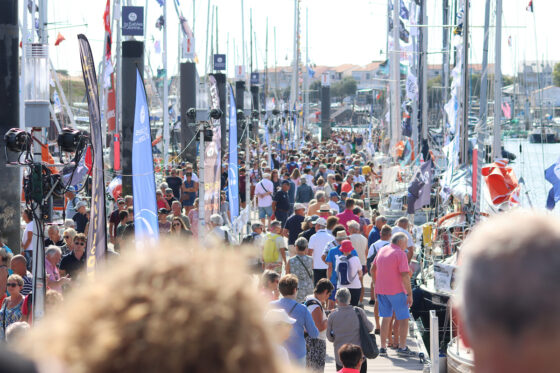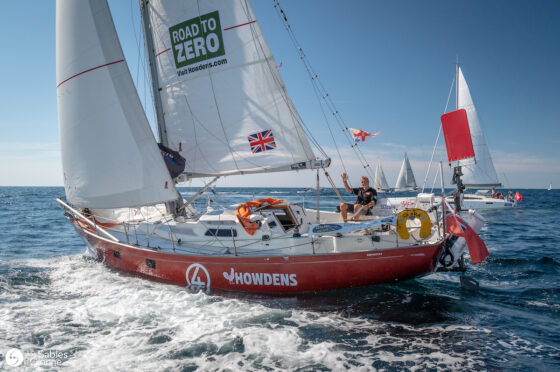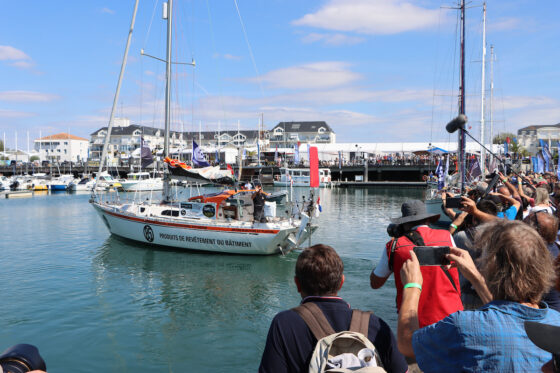
Sailors set off on solo round-the-world Golden Globe Race

Family and friends have bid an emotional farewell to 16 intrepid sailors and adventurers, who have set off from the French port of Les Sables D’Olonne on the third non-stop, solo, round-the-world Golden Globe Race.
The sailors departed port on Sunday (4 September 2022) and will attempt the nine month, 30,000-mile endeavour — billed as one of the world’s most dangerous and extreme sporting challenges.
Skippers in the race will be confined to their small, classic 32-36 ft yachts on their own, and will not use modern navigation techniques or assistance.
As a non-stop one-class race, the rules state that any entrant forced to make one stopover, or break the seal on their portable GPS chart plotter, is not eligible for a trophy or a refund on their entry fee, but can remain in the event, being moved to the ‘Chichester Class’. However, any entrant making two stops is disqualified.
All entrants will be tracked 24/7 by satellite, but competitors will not be able to access this information unless an emergency arises.
The race has its origins in the Sunday Times Golden Globe Race of 1968-69, which was the first round-the-world yacht race. Most competitors did not finish, including Brit Chay Blyth, who had no prior sailing experience (albeit had rowed the Atlantic), yet managed to sail around the Cape of Good Hope before retiring. Another entrant, Bernard Moitessier, decided to reject the idea of commercialised sailing while in pole position, then ended up sailing around the world one and a half times until he reached Tahiti.

Robin Knox-Johnston, Tapio Lehtinen, and the next generation of sailors. Photo courtesy Nora Havel / GGR2022
Robin Knox-Johnston was the only entrant to complete the race, becoming the first man to sail single-handed and non-stop around the world.
Due to controversy around the suicide of one entrant during the inaugural race, it was not held again until 1982 as the BOC Challenge race, inspired by the Golden Globe. The Vendee Globe, held every four years, is considered a successor to the Golden Globe.
In 2018, for the 50th anniversary of the first race, another Golden Globe took place, with entrants limited to similar equipment and boats to the original skippers. This year’s edition marks the 54th anniversary.
Following years of intense preparations and safety checks, the thought of nine months of total isolation, with only high-frequency radios to speak with family or friends, understandably proved daunting on the morning of departure.
The people of Les Sables d’Olonne turned out en masse to cheer the competitors, with the race village reportedly drawing 5,000 visitors per day.

The GGR dock has been a favourite among visitors. Photo courtesy Nora Havel / GGR2022
“To watch the sailors depart the marina was both humbling, exciting and electric,” says Don McIntyre, president and founder of the race. “We were all swept up in the emotion and human spirit on display. Trying to imagine the hardships and joy these sailors and dreamers will experience in the months ahead was hard.”
There are 15 men and one woman, South Africa’s Kirsten Neuschäfer, among the skippers. It was Britain’s Simon Curwen who crossed the line first on Sunday, followed shortly by France’s Damien Guillou on PRB, later joined by Neuschäfer. The trio quickly took the lead of the fleet towards Cape Finisterre, 350 miles south-west of Les Sables d’Olonne, which they are expected to reach by 8 September.

Simon Curwen onboard his Biscay 36 “Clara”. Photo courtesy of Les Sables d’Olonne
There was a moment of controversy when local French sailor Arnaud Gaist crossed the start line early by about one minute and was asked by the official starter to recross the line. He failed to do so. This will be addressed later, but organisers say as he sails the smallest yacht in the fleet, it is not expected to have any real impact.
Christian Dumard, the meteorologist for legendary races such as the Vendée Globe, the Volvo Ocean Race and the Mini Transat, says the conditions will be tough in the early stages.
“After a start in good conditions, the low-pressure system to the west of the Celtic Sea will bring strong south westerly winds,” he says. “It will be followed at the end of next week by the remains of cyclone Danielle, which formed in the middle of the Atlantic. It is therefore in a prevailing SW to W flow that the competitors will sail to Cape Finisterre, then probably to the latitude of Lisbon. The sea will be rough with waves of up to four metres. They will then be able to hit the Portuguese trade winds, the famous northerly winds that will enable them to sail downwind towards the Canary Islands and the Cape Verde Archipelago.”

Damien Guillou sets-off for his adventure with his Rustler 36 “PRB”. Photo courtesy of Nora Havel / GGR2022
There are two options in the immediate future: westwards towards heavy weather for the skippers who will want to make the difference during the first 24 hours, and a route favouring milder but more uncertain winds along the Asturian and Galician coastline. This choice, early in the race, could well lead to the first split of the fleet into two groups.
The Spaniard Aleix Selles, still waiting for his mast, chose to sail alongside the fleet and test his jury rig on his Rustler 36 Onsoro.
According to the Notice of Race, he may have one more week to rejoin the race and cross the start line south of Nouch, and benefit from good weather conditions. He is determined and could well add another twist to this 2022 edition.
